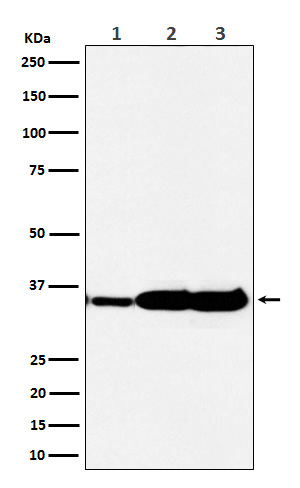HuR / ELAVL1 Antibody
Rabbit mAb
- 产品详情
- 实验流程
Application
| WB, IHC, IF, FC, ICC, IP, IHF |
|---|---|
| Primary Accession | Q15717 |
| Reactivity | Rat, Human, Mouse |
| Clonality | Monoclonal |
| Other Names | HUR; Hua; MelG; ELAV1; |
| Isotype | Rabbit IgG |
| Host | Rabbit |
| Calculated MW | 36092 Da |
| Dilution | WB 1:500~1:1000 IHC 1:50~1:200 ICC/IF 1:50~1:200 IP 1:40 FC 1:50 |
|---|---|
| Purification | Affinity-chromatography |
| Immunogen | A synthesized peptide derived from human HuR / ELAVL1 |
| Description | Involved in 3'-UTR ARE-mediated MYC stabilization. Binds avidly to the AU-rich element in FOS and IL3/interleukin-3 mRNAs. In the case of the FOS AU-rich element, HUR binds to a core element of 27 nucleotides that contain AUUUA, AUUUUA and AUUUUUA motifs. |
| Storage Condition and Buffer | Rabbit IgG in phosphate buffered saline , pH 7.4, 150mM NaCl, 0.02% sodium azide and 50% glycerol. Store at +4°C short term. Store at -20°C long term. Avoid freeze / thaw cycle. |
| Name | ELAVL1 |
|---|---|
| Synonyms | HUR |
| Function | RNA-binding protein that binds to the 3'-UTR region of mRNAs and increases their stability (PubMed:14517288, PubMed:18285462, PubMed:31358969). Involved in embryonic stem cell (ESC) differentiation: preferentially binds mRNAs that are not methylated by N6-methyladenosine (m6A), stabilizing them, promoting ESC differentiation (By similarity). Has also been shown to be capable of binding to m6A-containing mRNAs and contributes to MYC stability by binding to m6A-containing MYC mRNAs (PubMed:32245947). Binds to poly-U elements and AU-rich elements (AREs) in the 3'-UTR of target mRNAs (PubMed:14731398, PubMed:17632515, PubMed:18285462, PubMed:23519412, PubMed:8626503). Binds avidly to the AU-rich element in FOS and IL3/interleukin-3 mRNAs. In the case of the FOS AU-rich element, binds to a core element of 27 nucleotides that contain AUUUA, AUUUUA, and AUUUUUA motifs. Binds preferentially to the 5'-UUUU[AG]UUU-3' motif in vitro (PubMed:8626503). With ZNF385A, binds the 3'-UTR of p53/TP53 mRNA to control their nuclear export induced by CDKN2A. Hence, may regulate p53/TP53 expression and mediate in part the CDKN2A anti-proliferative activity. May also bind with ZNF385A the CCNB1 mRNA (By similarity). Increases the stability of the leptin mRNA harboring an AU-rich element (ARE) in its 3' UTR (PubMed:29180010). |
| Cellular Location | Cytoplasm. Nucleus. Cytoplasm, Stress granule {ECO:0000250|UniProtKB:P70372}. Cytoplasm, P-body. Note=Translocates into the cytoplasm following phosphorylation by MAPKAPK2 (PubMed:14517288). Likewise, phosphorylation by PRKCD promotes translocation from the nucleus into the cytoplasm, where it is associated with free and cytoskeleton-bound polysomes (PubMed:18285462). Localizes to the stress granules in the presence of PLEKHN1 (By similarity). {ECO:0000250|UniProtKB:P70372, ECO:0000269|PubMed:14517288, ECO:0000269|PubMed:18285462} |
| Tissue Location | Ubiquitous. Detected in brain, liver, thymus and muscle. |
Research Areas
For Research Use Only. Not For Use In Diagnostic Procedures.
Application Protocols
Provided below are standard protocols that you may find useful for product applications.
终于等到您。ABCEPTA(百远生物)抗体产品。
点击下方“我要评价 ”按钮提交您的反馈信息,您的反馈和评价是我们最宝贵的财富之一,
我们将在1-3个工作日内处理您的反馈信息。
如有疑问,联系:0512-88856768 tech-china@abcepta.com.
¥ 1,500.00
Cat# AP91610























 癌症的基本特征包括细胞增殖、血管生成、迁移、凋亡逃避机制和细胞永生等。找到癌症发生过程中这些通路的关键标记物和对应的抗体用于检测至关重要。
癌症的基本特征包括细胞增殖、血管生成、迁移、凋亡逃避机制和细胞永生等。找到癌症发生过程中这些通路的关键标记物和对应的抗体用于检测至关重要。 为您推荐一个泛素化位点预测神器——泛素化分析工具,可以为您的蛋白的泛素化位点作出预测和评分。
为您推荐一个泛素化位点预测神器——泛素化分析工具,可以为您的蛋白的泛素化位点作出预测和评分。 细胞自噬受体图形绘图工具为你的蛋白的细胞受体结合位点作出预测和评分,识别结合到自噬通路中的蛋白是非常重要的,便于让我们理解自噬在正常生理、病理过程中的作用,如发育、细胞分化、神经退化性疾病、压力条件下、感染和癌症。
细胞自噬受体图形绘图工具为你的蛋白的细胞受体结合位点作出预测和评分,识别结合到自噬通路中的蛋白是非常重要的,便于让我们理解自噬在正常生理、病理过程中的作用,如发育、细胞分化、神经退化性疾病、压力条件下、感染和癌症。






